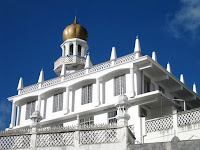
 Wild coast meets Saharan dunes. This should be enough to lure you to Mauritania. If you’re still diffident, a limited amount of hyperbole may strike a chord: think grandiose dune fields, ancient cities scoured by sandy winds, giddily deep canyons, eye-popping plateaus, sand seas larger than many a small European country and a phalanx of enchanting oases. Sure, you may find similar landscapes in other parts of West Africa, but few are on the same scale as those in Mauritania. And few are as varied. Where else could you find such a startling interplay of dunes and ocean? If it’s tranquillity you’re after, fear not: unlike Senegal, the Mauritanian coastline is completely virginal – expect kilometres of sandy beaches without a resort in sight.
Wild coast meets Saharan dunes. This should be enough to lure you to Mauritania. If you’re still diffident, a limited amount of hyperbole may strike a chord: think grandiose dune fields, ancient cities scoured by sandy winds, giddily deep canyons, eye-popping plateaus, sand seas larger than many a small European country and a phalanx of enchanting oases. Sure, you may find similar landscapes in other parts of West Africa, but few are on the same scale as those in Mauritania. And few are as varied. Where else could you find such a startling interplay of dunes and ocean? If it’s tranquillity you’re after, fear not: unlike Senegal, the Mauritanian coastline is completely virginal – expect kilometres of sandy beaches without a resort in sight.
 And it will remain forever: an immense stretch of seashore is protected, with Parc National du Banc d’Arguin ranking as one of the best bird-watching spots in the world – Nouâdhibou, a fishing port on the Atlantic Coast, is a good gateway to this region. Nouakchott will lure you after a spell in the desert with its bountiful fresh seafood. For outdoor-adventure types, Mauritania offers the full slate of trekking options as well as exhilarating camel trips amid surreal landscapes, not to mention hot-air ballooning in the The Adrar.
And it will remain forever: an immense stretch of seashore is protected, with Parc National du Banc d’Arguin ranking as one of the best bird-watching spots in the world – Nouâdhibou, a fishing port on the Atlantic Coast, is a good gateway to this region. Nouakchott will lure you after a spell in the desert with its bountiful fresh seafood. For outdoor-adventure types, Mauritania offers the full slate of trekking options as well as exhilarating camel trips amid surreal landscapes, not to mention hot-air ballooning in the The Adrar. But it’s not all about nature, landscapes and adrenaline: Mauritania is also of strong historical interest, with a sprinkle of World Heritage–listed caravan towns, all testifying to ancient civilisations. Culturally, Mauritania is a place apart; the population is almost equally divided between Moors of Arab descent and black Africans. It’s a Muslim country with a black African twist. This striking combination is part of its appeal.
But it’s not all about nature, landscapes and adrenaline: Mauritania is also of strong historical interest, with a sprinkle of World Heritage–listed caravan towns, all testifying to ancient civilisations. Culturally, Mauritania is a place apart; the population is almost equally divided between Moors of Arab descent and black Africans. It’s a Muslim country with a black African twist. This striking combination is part of its appeal.
 If you’re more inclined to ecotourism than mass tourism, Mauritania is your Shangri-la.
If you’re more inclined to ecotourism than mass tourism, Mauritania is your Shangri-la.Show in Lonely Planet









